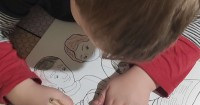What are the colors children would choose to use first for coloring?
Children take in everything they see and hear like a sponge. They rely on their sight to learn more about the world, so they react best to bright colors. Young children notice bright colors as they help a child distinguish form when looking at the world around them. Children begin to see colors by around the age of 5 months, and the brighter the colors, the easier they are to see. And as we have come to learn, colors can affect mood, which also affects behavior.
So, what are the brightest colors?
The brightest colors in the spectrum are those most attractive to children, like yellow, red, and blue, also known as the primary colors. Children also have an affinity for secondary colors, which include green, purple, and orange, whereas the shades and pastel colors, such as brown or grey, are less appealing. If you notice, marketing professionals who understand that children prefer the brightest colors when looking at toys and food packaging take advantage of this.
Bright colors are more stimulating than other colors.
This color preference in children is noticed at a very early age since they don’t have a mature sight, and they see those colors better, and that preference carries through their development. That’s because these colors are more stimulating as they are more noticeable, so children can better interact in a brightly colored environment.
Bright colors are also a learning source for children as they achieve success and confidence from the ability to sort through color patterns and learn their basic names. After all, it’s much easier for children to consider something red rather than a pink object. It’s basic vocabulary that is easier to pronounce. Success breeds more learning and developmental growth.
Change the Color and Change the Mood
Just as in the adult world, children can alter their moods and behaviors with a simple change of color. A bright yellow or orange space is cheerful in the room, whereas red can instill alertness and excitability. Meanwhile, cooler tones, like green or blue, can calm children and adults alike.
These mood-enhancing color choices are important in a child’s bedroom or classroom. A green or blue room would be more beneficial for better sleep than a red one. That is why it is great to use bright colors appropriately to maintain a child’s interest and engage them with the right behaviors.
It is only beneficial to use bright colors where children are around so that they can learn from and interact with them. They can begin associating bright colors with certain objects or concepts. Children quickly understand, for example, that red is the color of some foods, like apples, fire, or anger. Bright colors are useful in educating children and are an important part of child development, which is why we use them so much for coloring activities.

